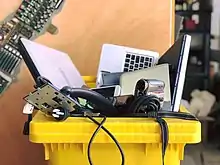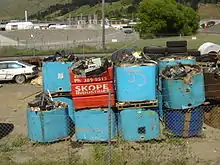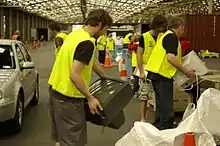Electronic waste in New Zealand
Electronic waste in New Zealand is an environmental issue being addressed by community and government initiatives.


"E-waste is the fastest-growing toxic waste stream in New Zealand. Every year, New Zealand generates over 80,000 tonnes of electronic waste, much of which contain toxic elements. New Zealand lags behind many of our major trading partners in terms of e-waste legislation.
At this stage, New Zealand effectively has no e-waste disposal controls. In the past, there have been two commendable Government-funded initiatives carried out: the e-Day collections, and the TV takeback campaign. Unfortunately, these programmes no longer operate.
E-waste can be turned into e-scrap by recycling it, and promisingly, New Zealand has a small but growing e-scrap processing industry"[1]
Background
In 2006 there was an estimated 3.4 million televisions, 3.3 million mobile phones, 1.9 million computers and monitors, and 600,000 laptops.[2] In the same year a survey showed that two-thirds of respondents were willing to pay for safe disposal of electronic waste such as televisions and computers. The remainder were unwilling to pay anything or were unsure. The survey also showed that 85% were willing to take items to a neighbourhood collection point.[3]
"The International Telecommunications Union (ITU) singled out New Zealand and Australia in a report published overnight on Wednesday, saying they together produced the highest volumes of e-waste in the world while noting they had among the lowest documented rates for recycling" [4]
eDay

eDay was a nationwide collection programme for electronic waste which ran from 2006 to 2010. A total of 54 tonnes was collected in the first year of operation and by 2009 this had risen to 946 tonnes. The event did not run in 2011 or any subsequent year, because the government ceased to provide funding.[5]
Legislation
New Zealand signed the Basel Convention in 1989 and ratified it in 1994.[6] The Basel Convention is an international treaty to reduce the movements of hazardous waste between nations, and specifically to prevent transfer of hazardous waste from developed to less developed countries. Electronic waste can be of a type defined under the convention.
It was not until 2006 that the first application was made for export of hazardous waste under the Basel Convention.[7]
Government initiatives
In 2010 the government put $750,000 towards the eDay event which is to be held in 40 different locations. Another $400,000 was allocated towards setting up collection depots and recycling centres around New Zealand.[8]
See also
References
- https://www.scoop.co.nz/stories/BU1906/S00713/toxic-timebomb-the-impact-of-e-waste-on-our-environment.htm
- Electrical and Electronic Equipment Survey January 2006: A Quantitative Report. ME765. Ministry for the Environment. June 2006. ISBN 0-478-30100-6.
- Electrical and Electronic Equipment Disposal Survey April 2006: A Quantitative Report. ME764. Ministry for the Environment. April 2006. ISBN 0-478-25999-9.
- https://www.stuff.co.nz/business/industries/99848483/unbacked-body-singles-out-new-zealand-as-an-ewaste-laggard
- http://www.eday.org.nz/template/media_questions__answers.pdf
- "Importing or Exporting Waste in New Zealand (Basel Convention): Requirements" (PDF). Ministry of Economic Development. November 2004. Retrieved 11 October 2010.
- Beston, Anne (12 August 2006). "'Toxic time bombs' ticking away". The New Zealand Herald. Retrieved 11 October 2010.
- Beehive (6 October 2010). "Govt steps up e-waste recycling". NZ Government. Retrieved 10 October 2010.
External links
| Wikimedia Commons has media related to Electronic waste in New Zealand. |
- Electronic waste at the Ministry for the Environment
- News
- {{cite news|https://www.scoop.co.nz/stories/PO1910/S00039/how-buying-second-hand-can-save-your-pocket-and-the-planet.htm
- {{cite news|https://www.rnz.co.nz/international/pacific-news/394939/call-for-changes-to-tackle-e-waste-in-pacific</ref>
- {{cite news|https://www.scoop.co.nz/stories/BU1904/S00631/e-waste-new-zealands-next-soft-plastic-epidemic.htm</ref>
- Pullar-Strecker, Tom (29 March 2004). "Ministry promises action on e-waste". Dominion Post.
- "Electronic waste is a growing issue". Nelson Mail. 6 August 2010. Retrieved 11 October 2010.